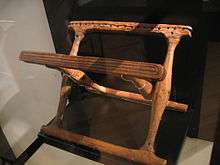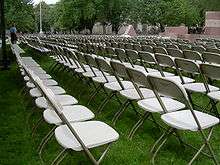Folding chair


A folding chair is a light, portable chair that folds flat, and can be stored in a stack, row, or on a cart.
Uses
Folding chairs are generally used for seating in areas where permanent seating is not possible or practical. This includes outdoor and indoor events such as funerals, college graduations, religious services, and sporting events and competitions. They are often used as weapons in professional wrestling.
Folding chairs are also used in the home for any situation requiring extra seating. This includes parties, card games, and temporary seating at the dinner table.
Some folding chairs are rocking chairs as well.
History


Folding chairs were already being used in Viking Sweden, Ancient Egypt, Greece and Rome. The frame was mostly made of wood, and seldom made of metal. The wood was inlaid with artistic carvings, gilded, and decorated with ivory. In Northern Europe, the remains of more than 18 folding chairs are known dating back to the Nordic Bronze Age such as the Daensen folding chair.
The folding chair became especially widespread during the Middle Ages. It was treasured as a liturgical furniture piece. Since the 15th and 16th centuries the folding chair has mostly had arm and head rests. Of course, newer chairs which are often found in functions and events are also called folding chairs. The folding chairs were very easy to use and bring to different places such as parties or family gatherings.
In the United States, an early patent for a folding chair was by John Cham in 1855.[2] In 1947, Fredric Arnold created the first aluminum folding chair with fabric strapping for the seat and back. By 1957, the Fredric Arnold Company of Brooklyn, New York, was manufacturing more than 14,000 chairs per day. Today, the folding chair is mostly made of hard plastic or metal or wood. Folding chairs can be divided into different categories.
Design
Folding chairs typically weigh between 2 to 5 kilograms (4.4 to 11.0 pounds) and are produced in a variety of styles, folding mechanisms, and materials.
Leg pivoting
Folding chair legs can pivot to fold either under the seat, or at the seat.
Most folding chairs pivot at the seat level. The seat aligns between the back supports. The back support and the front legs are the same part. There are, however, several designs that fold under the seat. Side-X stools consist if two X-shaped pieces with a sheet of cloth between them that becomes the seat. Front-X chairs are similar to side-X stools, but have the addition of a backrest. Side-X chairs are unique because the support for the backrest and front foot is the same part. The seat is collapsed to align between the sidebars, either down between the front legs, or up to align between back-sidebars. Mechanisms vary, but the supports for the back and the front feet are invariably the same part.
Pricing

Prices and quality can be roughly divided into four categories, and is largely the same as for stacking chairs:
Low range
Light and inexpensive furniture usually made from steel tubing, with a plastic seat and backrest. This style is very common in homes, churches, schools, and community events.
Mid range
Sturdy and a greater variety in styles and materials. They are typically not upholstered. Costs from approximately 25 dollars a piece (2008). Primary market is seating for large arenas, outdoor or places of worship but also cafes and brasseries.
Upper range
These folding chairs are often multiple reinforced, and come with padded seats and backrest. These are mainly sold for sporting events. The seat is sometimes made to fall backward so that it stands upright, making rainwater run off the upholstered seat.
High end
Folding chairs in this category are extremely few and are sold in a very small volume. They cost from 150 to 300 dollars a piece. They may be upholstered, but often they are priced higher because they are associated with a renowned manufacturer.